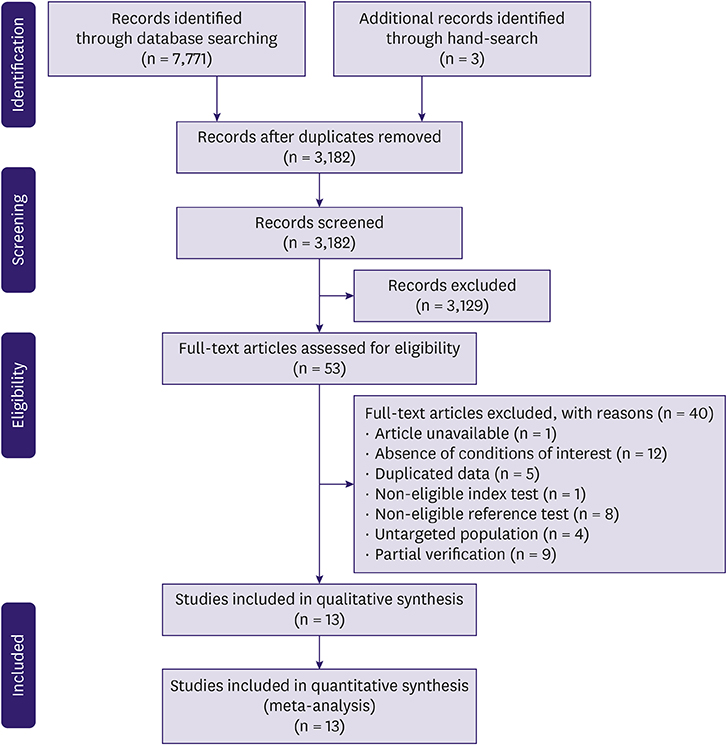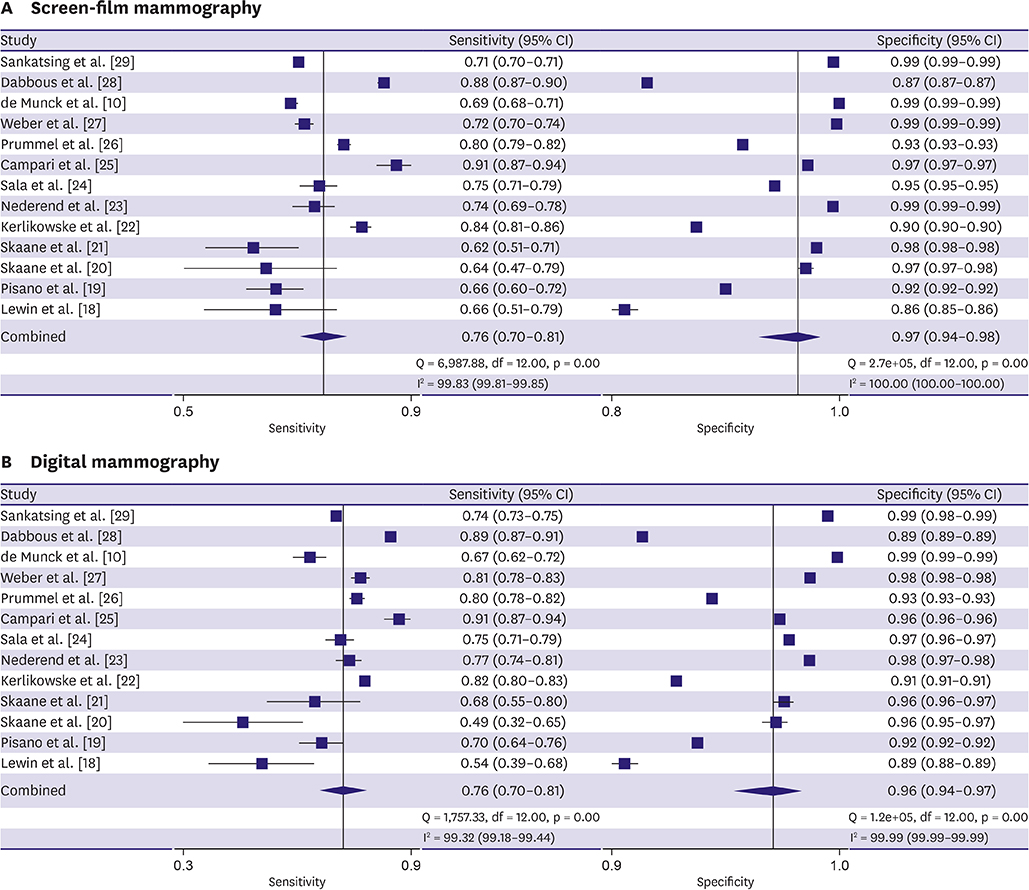J Breast Cancer.
2019 Jun;22(2):311-325. 10.4048/jbc.2019.22.e24.
Comparison of Digital and Screen-Film Mammography for Breast-Cancer Screening: A Systematic Review and Meta-Analysis
- Affiliations
-
- 1National Cancer Control Institute, National Cancer Center, Goyang, Korea. jkjun@ncc.re.kr
- 2Department of Medicine, Hanyang University College of Medicine, Seoul, Korea.
- 3Department of Radiology, Severance Hospital, Research Institute of Radiological Science, Yonsei University College of Medicine, Seoul, Korea.
- 4Department of Radiology, Soonchunhyang University Hospital Bucheon, Soonchunhyang University College of Medicine, Bucheon, Korea.
- 5Graduate School of Cancer Science and Policy, National Cancer Center, Goyang, Korea.
- KMID: 2450124
- DOI: http://doi.org/10.4048/jbc.2019.22.e24
Abstract
- PURPOSE
Digital mammography (DM) has replaced screen-film mammography (SFM). However, findings of comparisons between the performance indicators of DM and SFM for breast-cancer screening have been inconsistent. Moreover, the summarized results from studies comparing the performance of screening mammography according to device type vary over time. Therefore, this study aimed to compare the performance of DM and SFM using recently published data.
METHODS
The MEDLINE, Embase, and Cochrane Library databases were searched for paired studies, cohorts, and randomized controlled trials published through 2018 that compared the performance of DM and SFM. All studies comparing the diagnostic accuracy of DM and SFM in asymptomatic, average-risk women aged 40 years and older were included. Two reviewers independently assessed the study quality and extracted the data.
RESULTS
Thirteen studies were included in the meta-analysis. The pooled sensitivity (DM, 0.76 [95% confidence interval {CI}, 0.70-0.81]; SFM, 0.76 [95% CI, 0.70-0.81]), specificity (DM, 0.96 [95% CI, 0.94-0.97]; SFM, 0.97 [95% CI, 0.94-0.98]), and area under the receiver-operating characteristic curve (DM, 0.94 [95% CI, 0.92-0.96]; SFM, 0.92 [95% CI, 0.89-0.94]) were similar for both DM and SFM. The pooled screening performance indicators reinforced superior accuracy of full-field DM, which is a more advanced type of mammography, than SFM. The advantage of DM appeared greater among women aged 50 years or older. There was high heterogeneity among studies in the pooled sensitivity, specificity, and overall diagnostic accuracy estimates. Stratifying by study design (prospective or retrospective) and removing studies with a 2-year or greater follow-up period resulted in homogeneous overall diagnostic accuracy estimates.
CONCLUSION
The breast-cancer screening performance of DM is similar to that of SFM. The diagnostic performance of DM depends on the study design, and, in terms of performance, full-field DM is superior to SFM, unlike computed radiography systems.
Keyword
MeSH Terms
Figure
Reference
-
1. Hambly NM, McNicholas MM, Phelan N, Hargaden GC, O'Doherty A, Flanagan FL. Comparison of digital mammography and screen-film mammography in breast cancer screening: a review in the Irish breast screening program. AJR Am J Roentgenol. 2009; 193:1010–1018.
Article2. Vinnicombe S, Pinto Pereira SM, McCormack VA, Shiel S, Perry N, Dos Santos Silva IM. Full-field digital versus screen-film mammography: comparison within the UK breast screening program and systematic review of published data. Radiology. 2009; 251:347–358.
Article3. Timmermans L, De Hauwere A, Bacher K, Bosmans H, Lemmens K, Bleyen L, et al. Impact of the digitalisation of mammography on performance parameters and breast dose in the Flemish Breast Cancer Screening Programme. Eur Radiol. 2014; 24:1808–1819.
Article4. Comas M, Arrospide A, Mar J, Sala M, Vilaprinyó E, Hernández C, et al. Budget impact analysis of switching to digital mammography in a population-based breast cancer screening program: a discrete event simulation model. PLoS One. 2014; 9:e97459.
Article5. Pisano ED, Hendrick RE, Yaffe MJ, Baum JK, Acharyya S, Cormack JB, et al. Diagnostic accuracy of digital versus film mammography: exploratory analysis of selected population subgroups in DMIST. Radiology. 2008; 246:376–383.
Article6. Bluekens AM, Holland R, Karssemeijer N, Broeders MJ, den Heeten GJ. Comparison of digital screening mammography and screen-film mammography in the early detection of clinically relevant cancers: a multicenter study. Radiology. 2012; 265:707–714.
Article7. Nederend J, Duijm LE, Louwman MW, Groenewoud JH, Donkers-van Rossum AB, Voogd AC. Impact of transition from analog screening mammography to digital screening mammography on screening outcome in The Netherlands: a population-based study. Ann Oncol. 2012; 23:3098–3103.
Article8. van Luijt PA, Fracheboud J, Heijnsdijk EA, den Heeten GJ, de Koning HJ. National Evaluation Team for Breast Cancer Screening in Netherlands Study Group (NETB). Nation-wide data on screening performance during the transition to digital mammography: observations in 6 million screens. Eur J Cancer. 2013; 49:3517–3525.
Article9. Karssemeijer N, Bluekens AM, Beijerinck D, Deurenberg JJ, Beekman M, Visser R, et al. Breast cancer screening results 5 years after introduction of digital mammography in a population-based screening program. Radiology. 2009; 253:353–358.
Article10. de Munck L, de Bock GH, Otter R, Reiding D, Broeders MJ, Willemse PH, et al. Digital vs screen-film mammography in population-based breast cancer screening: performance indicators and tumour characteristics of screen-detected and interval cancers. Br J Cancer. 2016; 115:517–524.
Article11. Iared W, Shigueoka DC, Torloni MR, Velloni FG, Ajzen SA, Atallah AN, et al. Comparative evaluation of digital mammography and film mammography: systematic review and meta-analysis. Sao Paulo Med J. 2011; 129:250–260.
Article12. Souza FH, Wendland EM, Rosa MI, Polanczyk CA. Is full-field digital mammography more accurate than screen-film mammography in overall population screening? A systematic review and meta-analysis. Breast. 2013; 22:217–224.
Article13. Moher D, Liberati A, Tetzlaff J, Altman DG. PRISMA Group. Preferred reporting items for systematic reviews and meta-analyses: the PRISMA statement. Ann Intern Med. 2009; 151:264–269.
Article14. Whiting PF, Rutjes AW, Westwood ME, Mallett S, Deeks JJ, Reitsma JB, et al. QUADAS-2: a revised tool for the quality assessment of diagnostic accuracy studies. Ann Intern Med. 2011; 155:529–536.
Article15. Reitsma JB, Glas AS, Rutjes AW, Scholten RJ, Bossuyt PM, Zwinderman AH. Bivariate analysis of sensitivity and specificity produces informative summary measures in diagnostic reviews. J Clin Epidemiol. 2005; 58:982–990.
Article16. Rutter CM, Gatsonis CA. A hierarchical regression approach to meta-analysis of diagnostic test accuracy evaluations. Stat Med. 2001; 20:2865–2884.
Article17. Higgins JP, Thompson SG, Deeks JJ, Altman DG. Measuring inconsistency in meta-analyses. BMJ. 2003; 327:557–560.
Article18. Lewin JM, D'Orsi CJ, Hendrick RE, Moss LJ, Isaacs PK, Karellas A, et al. Clinical comparison of full-field digital mammography and screen-film mammography for detection of breast cancer. AJR Am J Roentgenol. 2002; 179:671–677.
Article19. Pisano ED, Gatsonis C, Hendrick E, Yaffe M, Baum JK, Acharyya S, et al. Diagnostic performance of digital versus film mammography for breast-cancer screening. N Engl J Med. 2005; 353:1773–1783.
Article20. Skaane P, Skjennald A, Young K, Egge E, Jebsen I, Sager EM, et al. Follow-up and final results of the Oslo I Study comparing screen-film mammography and full-field digital mammography with soft-copy reading. Acta Radiol. 2005; 46:679–689.
Article21. Skaane P, Hofvind S, Skjennald A. Randomized trial of screen-film versus full-field digital mammography with soft-copy reading in population-based screening program: follow-up and final results of Oslo II study. Radiology. 2007; 244:708–717.
Article22. Kerlikowske K, Hubbard RA, Miglioretti DL, Geller BM, Yankaskas BC, Lehman CD, et al. Comparative effectiveness of digital versus film-screen mammography in community practice in the United States: a cohort study. Ann Intern Med. 2011; 155:493–502.
Article23. Nederend J, Duijm LE, Louwman MW, Coebergh JW, Roumen RM, Lohle PN, et al. Impact of the transition from screen-film to digital screening mammography on interval cancer characteristics and treatment - a population based study from The Netherlands. Eur J Cancer. 2014; 50:31–39.
Article24. Sala M, Domingo L, Macià F, Comas M, Burón A, Castells X. Does digital mammography suppose an advance in early diagnosis? Trends in performance indicators 6 years after digitalization. Eur Radiol. 2015; 25:850–859.
Article25. Campari C, Giorgi Rossi P, Mori CA, Ravaioli S, Nitrosi A, Vacondio R, et al. Impact of the introduction of digital mammography in an organized screening program on the recall and detection rate. J Digit Imaging. 2016; 29:235–242.
Article26. Prummel MV, Muradali D, Shumak R, Majpruz V, Brown P, Jiang H, et al. Digital compared with screen-film mammography: measures of diagnostic accuracy among women screened in the Ontario Breast Screening Program. Radiology. 2016; 278:365–373.
Article27. Weber RJ, van Bommel RM, Louwman MW, Nederend J, Voogd AC, Jansen FH, et al. Characteristics and prognosis of interval cancers after biennial screen-film or full-field digital screening mammography. Breast Cancer Res Treat. 2016; 158:471–483.
Article28. Dabbous F, Dolecek TA, Friedewald SM, Tossas-Milligan KY, Macarol T, Summerfelt WT, et al. Performance characteristics of digital vs film screen mammography in community practice. Breast J. 2018; 24:369–372.
Article29. Sankatsing VD, Fracheboud J, de Munck L, Broeders MJ, van Ravesteyn NT, Heijnsdijk EA, et al. Detection and interval cancer rates during the transition from screen-film to digital mammography in population-based screening. BMC Cancer. 2018; 18:256.
Article



